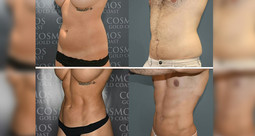If you’re exploring options for jawline shape changes, Cosmos Clinic provides a range of non-surgical and surgical treatments to address individual concerns.
Non-Surgical Treatments
Non-surgical options may be suitable for those looking for less invasive procedures. These treatments can address specific concerns related to the jawline and chin:
Dermal Filler
Dermal fillers can be used to change the structure and shape of the jawline or chin. This treatment typically provides immediate results, with effects lasting between 12 to 18 months. Injectable fillers may also be used to change the appearance of a small or recessed chin.
Muscle Relaxant Injections
Muscle relaxant injections target the masseter muscles, which can become overdeveloped over time. By relaxing these muscles, the procedure can change the jawline’s appearance. Repeat treatments are generally required every 3–4 months to maintain the results.
Fat Dissolving Treatments (Kybella)
Designed to reduce excess fat deposits beneath the chin, Kybella treatment targets fat cells, breaking them down for the body to naturally process. The effects are usually long-lasting, as the targeted fat cells do not regenerate.
Surgical Treatments
Surgical options are available for those seeking more significant or lasting changes to the jawline or chin. These procedures include:
Neck Lift Surgery
Neck lift surgery involves the removal of excess tissue and the repositioning of the underlying muscles to change the neck appearance. Incisions are typically placed in discreet areas near the ears or hairline.
Neck Liposuction with Vaser Technology
Vaser liposuction uses ultrasound energy to break down fat cells in the neck and jawline area. This approach may also stimulate collagen production, contributing to the treatment’s effects.
Chin Surgery (Mentoplasty)
This surgical procedure changes the shape or size of the chin using implants or by modifying the bone. It may be recommended for individuals with specific chin concerns, such as retrogenia.
Chin Augmentation (Sliding Genioplasty)
This technique repositions the chin bone to address its shape or alignment. Sliding genioplasty may also be performed alongside other surgical treatments to achieve comprehensive outcomes.
Neck Liposuction as an Alternative
Neck liposuction using Vaser technology can provide an option for individuals who may not want or require a full surgical neck lift. The procedure is typically performed under twilight sedation and involves the use of ultrasound energy to break down fat cells and tighten the treatment area.
Recovery from this procedure is usually quick, with most patients resuming daily activities within a day or two. Compression garments are recommended for healing and results, which continue to develop over 6 to 12 weeks post-procedure.
Potential Risks of Jaw Surgery
Any cosmetic procedure, whether surgical or non-surgical, carries potential risks and side effects. It’s important to discuss these thoroughly with your doctor during the consultation to make an informed decision. The following risks may apply to jawline and chin procedures:
Non-Surgical Risks
- Swelling or Bruising: Common after injectable treatments but typically resolves within a few days.
- Asymmetry: Results may not be perfectly symmetrical and may require additional treatment.
- Allergic Reaction: Rare, but possible with injectable treatments.
- Lumpiness or Uneven Results: Improper filler placement can lead to unevenness.
- Temporary Weakness: Muscle relaxants may cause temporary changes in muscle function.
Surgical Risks
- Infection: As with any invasive procedure, there is a risk of infection at the incision site.
- Scarring: Small scars may develop, but they are usually minimal and fade over time.
- Nerve Damage: Rare, but there is a possibility of temporary or permanent numbness or tingling in the treated area.
- Blood Clots: Rare but serious risk associated with surgical procedures.
- Hematoma: Accumulation of blood under the skin, which may require drainage.
- Poor Healing: Individual healing responses vary, and some may experience prolonged recovery.
- Unsatisfactory Results: Results may not meet expectations and could require revision procedures.
General Risks
- Allergic Reaction to Anesthesia: Some patients may react to anesthesia used during surgery.
- Prolonged Swelling: Swelling may take longer to subside in some individuals.
- Skin Irregularities: Minor bumps or uneven texture may occur post-treatment.






